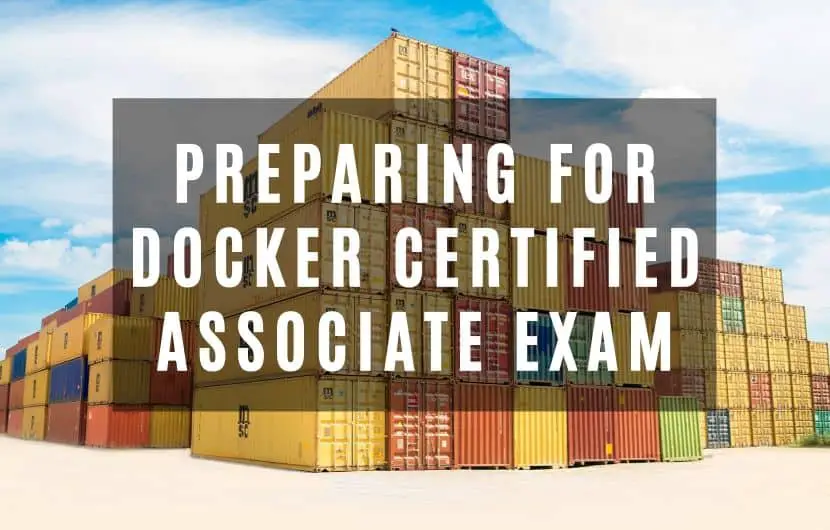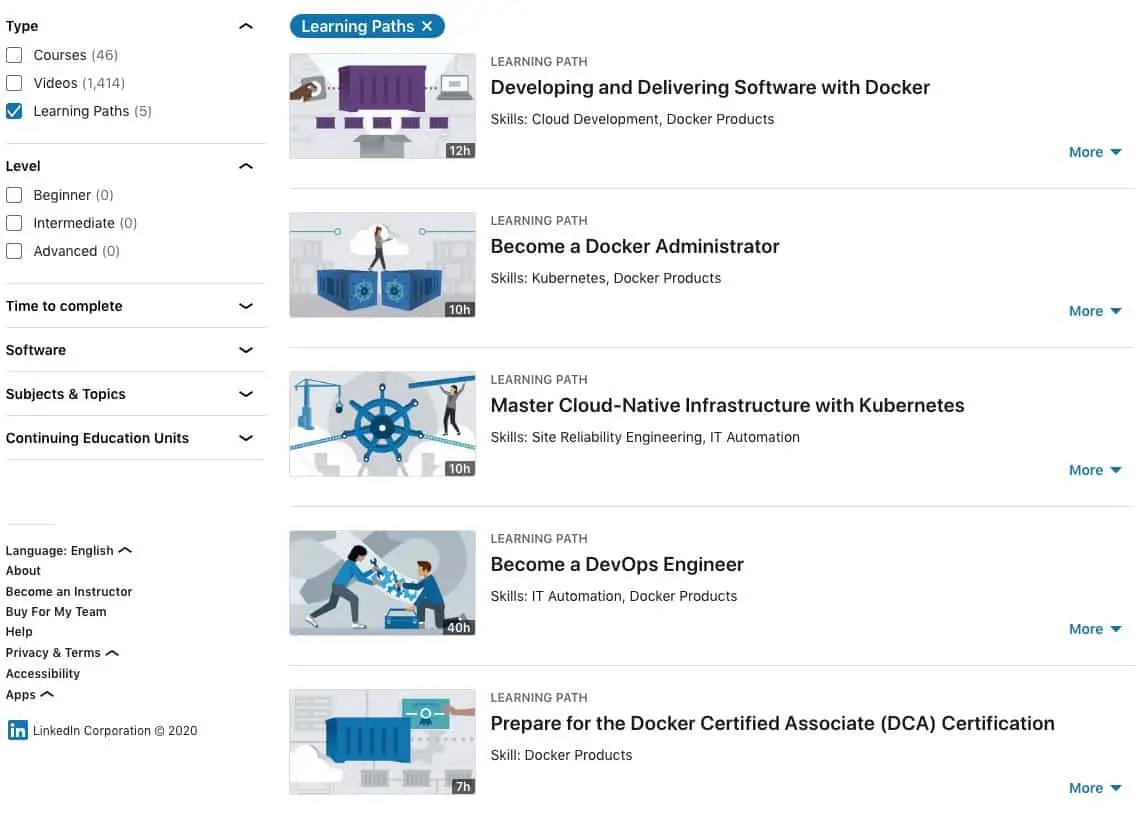[RH_ELEMENTOR id=”7801″]
The Docker certification exam, if passed, is an addition to your resume that gives you an edge over others in the labor market. While your certificate might not necessarily be a guarantee that you will get a job, it is a plus that will be considered, amongst other things. However, to enjoy the value that comes with Docker certification, you have to first pass the examination.
Training courses can significantly assist you in preparing for the Docker Certification Exam. On LinkedIn Learning, you can get a risk-free 30 days free trial, during which you can do a few Docker Learning Paths, and much more.
Checkout all Docker Learning Paths here
[wpsm_toplist]
Docker certification, among many other things, shows that you have the necessary technical knowledge to work with Docker. At the time of writing this article, it is the first and only professional certification for Docker container technologies. Many companies that make use of Docker containers need the knowledge of someone who has a Docker Certified Associate (DCA) to handle the platform. With this certification exam, you can become one of these valuable people companies are seeking.
Before getting into the details of how to be prepared for this professional certification, let us examine some of the benefits that it offers.
Benefits of Docker Certification
[wpsm_list type=”arrow”]
- Your Docker skills are recognized. This certification is recognized worldwide and it amplifies your Docker skills and provides you with an official Docker credential. This credential is what validates that you have these skills upon completion of the examination.
- Allows easy access and use of the Docker Certified Associate logo. On completion of the certification exam, successful candidates have a digital certificate and can make use of the Docker Certified Associate logo.
- Employers can easily verify certificate status.
- Unlimited access to professionals and certified-only events. On completion of the Docker certification exam, successful individuals will have access to a wide network of professionals. Being a part of this network helps you to grow your reach, find your dream job, and attend high-value conferences.
[/wpsm_list]
To become a Docker certified individual, you have to earn a passing score on the examination. When you earn this score or above, then, you will receive your certification and enjoy the many benefits that come with being certified. Without attaining this passing score, you will not be able to receive your certification credentials. This is why it is very important that you know how to prepare for the Docker certification exam to reach the passing score, as is explored below.
Knowing What Docker Certification Entails
Docker is a developer tool that makes it easy for enterprises to create, deploy, and execute applications while making use of containers. I’m sure you’ve heard someone saying (or screaming):
…but it works on my machine!
Docker containers eliminate such problems, so everyone can be sure that the applications will run the same way on any machine that has a Docker installed.
Docker certification is one of the most in-demand certifications of the modern era. Many companies these days make use of the Docker platform and as such, require the services of Docker certified associates. So, with a Docker certified credential, you become very valuable to companies that are using Docker in their project development cycle, deployment, or production.
This certification was officially launched in 2017, with a certification page that provides individuals with details of what the certification entails. This page also provides the level of expertise a Docker certified associate can operate in, and it includes:
[wpsm_list type=”arrow”]
- Ability to launch and run applications from pre-existing images
- Ability to deploy images across the cluster
- Ability to install and operate the Docker platform
- Ability to analyze and provide solutions to triage issues from stakeholders
- Ability to configure and maintain new Docker environments
- Ability to effectively migrate non-containerized applications to containers
[/wpsm_list]
Docker Certification Requirements
Just knowing about the Docker tools and the certification examination is not enough to pass the examination. To pass the Docker Certification exam and become a Docker professional, knowing the certification requirements is very important. Generally, there are three major requirements to pass Docker examination – super good knowledge regarding Docker and its tooling, networking knowledge, and IT knowledge in general.
Individuals preparing for this examination must have gathered good knowledge, both theoretical and practical, about the Docker platform and its features. The exam is designed in such a way that you’ll be required to show off your Docker skills. You will need to be able to demonstrate your knowledge of how you can build Docker images using Dockerfiles and docker-compose files, how you can run Docker containers off those images, show that you understand how Docker image layers work, and also, demonstrate that you can inspect and explain everything regarding the containers and their images. Make sure that you also know the Docker command line commands and can explain what does what with confidence.
Docker containers are usually connected to a network and can reach each other over the wires. Docker allows you to create your virtual networks and connect your containers into them. So it’s worth knowing how networking works in general, then learning the specific Docker networking topics. Please take this topic very seriously, as you will need it in real-life jobs.
The third requirement that is imperative for success in the Docker certification exam is IT knowledge. This shows that you understand the nitty-gritty of technology. Here, being in line with the recent technological trend is very important and provides an edge over other people. Being knowledgeable in programming languages, computer networking, Linux, or Windows administration (especially in the command lines) will help you to succeed in the examination as well.
The Pattern of the Examination
The Docker certification exam has a specific pattern and understanding the pattern aids your preparation. However, before examining the pattern, candidates need to know the test item format:
[wpsm_list type=”arrow”]
- Multiple-choice – only one answer is correct
- Multiple-response – more than one correct answer
- Sample directions – read the statement or question, and, from the response options, select only the option(s) that represent the most correct or best answer(s) given the information
[/wpsm_list]
The patterns in which the Docker Certification Exam is grouped are referred to as domains. There are six of these domains and they include:
Orchestration
This domain takes 25% of the examination which is the largest taken by any domain, making it the most important. Here, candidates are expected to do the following:
[wpsm_video]https://www.youtube.com/watch?v=kBF6Bvth0zw[/wpsm_video]
[wpsm_list type=”arrow”]
- Completely set up a swarm mode cluster, with managers and worker nodes within a specified time range. So here, it is not just about how well, but also how fast it can be done.
- Differentiate between running a container and running a service, with examples to show for the two.
- Show with clear and identifiable steps how a swarm cluster can be effectively locked and unlocked for access and restrictions.
- Provide instructions that can be used to run individual containers into running services under swarm in the most effective way possible.
- Appropriately interpret the output of the “docker inspect” command.
- Easily and effectively manipulate a stack of running services and increase the number of replicas.
- Convert an application deployment into a stack file using a YAML compose file with “docker stack deploy”.
- Mount volumes on Docker containers, add networks, and publish ports.
- Explain, with examples, how one can run a replicated and global service.
- Must be able to identify the necessary steps to be followed in troubleshooting a service that is not deploying.
- Apply node labels to demonstrate placement of tasks.
- Illustrate how applications on the platform interact with legacy systems.
- State in clear terms the importance and usage of quorum in a swarm cluster.
- Demonstrate the usage of templates.
[/wpsm_list]
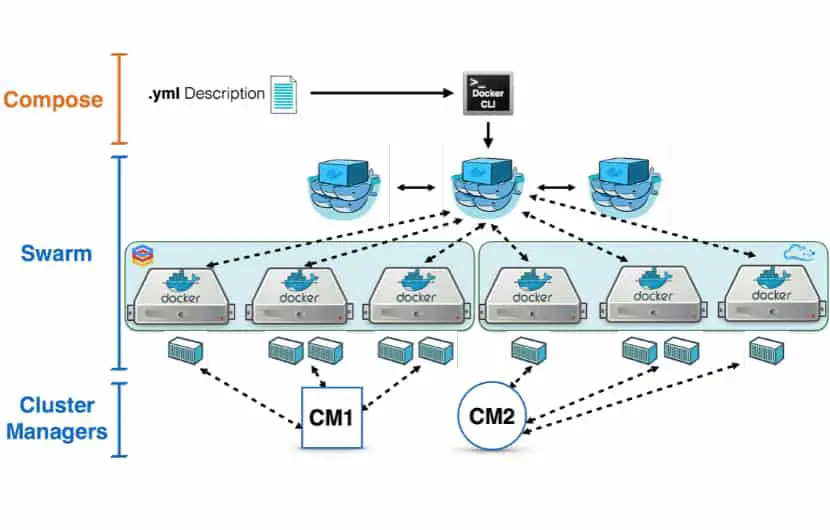
Where should you start learning the Orchestration bits
You will need to know how to set up and manage the Docker swarm cluster inside out, but you can start learning the orchestration bits by describing and deploying your applications.
Imagine you had an application described in the following stack file:

And then you deploy your application to the swarm cluster by doing the following:

Make sure you go through the official documentation, read it thoroughly, and apply your knowledge into practice.
Image Creation, Management, and Registry
This domain is the second most important domain and it takes 20% of the examination. Here, candidates are expected to demonstrate skills in the following areas:
[wpsm_list type=”arrow”]
- Ability to show, describe, and make use of the many Dockerfile options which include – ‘add’, ‘copy’, ‘volumes’, ‘expose’, and ‘entrypoint’ among others.
- Explain the Dockerfile.
- Explain with illustrations how best an image can be created from a Dockerfile.
- Ability to use CLI commands for image management, such as: ‘list’, ‘delete’, ‘prune’, ‘rmi’.
- Monitor images created, and analyze them making use of the necessary filter and format.
- Tag images and make use of a registry to store the images.
- Display layers of a Docker image.
- Ability to explain how image layers work.
- Apply a file to create a Docker image.
- Deploy a registry.
- Provide explanations as to how to log into a registry, utilize search in the registry, tag, and push images into a registry.
- Ability to sign an image in a registry and also to pull one from a registry.
- Describe how image deletion works, both from the host machine and from a registry.
[/wpsm_list]
[wpsm_video]https://www.youtube.com/watch?v=vlS5EiapiII[/wpsm_video]
Where should you start learning about Docker images
This is one of the essential Docker things and is one of the few pillars in the Docker world. You must have a thorough understanding of Docker images really well. Again, start with reading the official Docker documentation and making sure you have a thorough understanding of images and how to manage them.
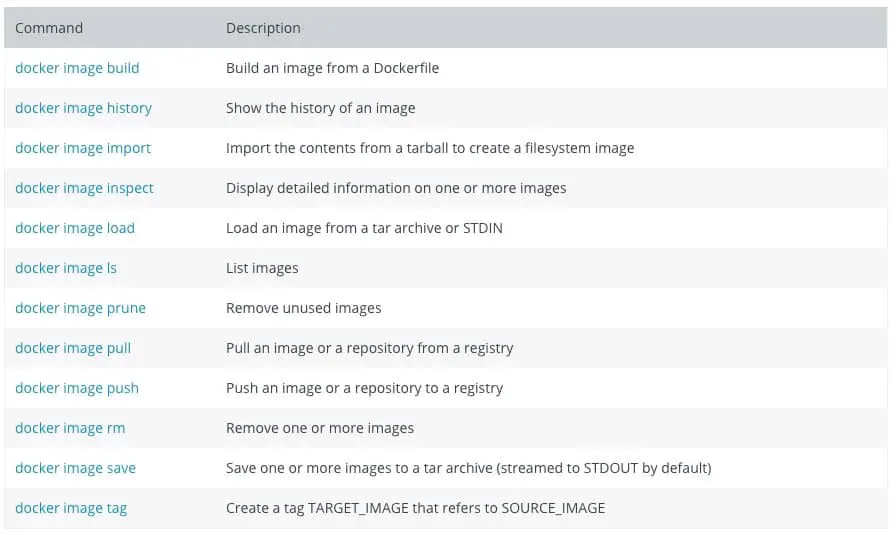
Installation and Configuration
This domain of the Docker certification examination takes 15% of the exam. Here, the IT knowledge of candidates is determined as they are being tested on the following:
[wpsm_list type=”arrow”]
- Ability to effectively upgrade the Docker engine without any fault.
- Ability to complete the necessary steps needed for setting up a repo, selection of storage driver, and complete the installation of the Docker engine on multiple platforms.
- Knowledge of effective configuration of logging drivers (splunk, journald, etc), managers and add nodes.
- Ability to set up a backup schedule.
- Create and manage both users and a team on multiple platforms.
- Interpret errors to troubleshoot installation issues without assistance.
- Outline the sizing requirements prior to installation.
- Ability to understand namespaces, cgroups, and configuration of certificates.
- Consistently repeat steps to deploy Docker engine, UCP, and DTR on AWS and on-premises in an HA configuration.
- Ability to effectively configure backups for UCP and DTR and also ensure the Docker daemon to start on boot.
[/wpsm_list]
[wpsm_video]https://www.youtube.com/watch?v=V9AKvZZCWLc[/wpsm_video]
Start learning about Docker installation and configuration
If you’re a complete newbie in using Docker, I would recommend you try and install Docker on some Linux machine. It can be installed straight on your local machine or if you feel serious about learning Docker, have a look at Digital Ocean droplets. They are relatively cheap and gives you a realistic Linux environment to work on with the Docker. Make sure you can issue the following commands as your first steps. And of course, read the official Docker documentation.
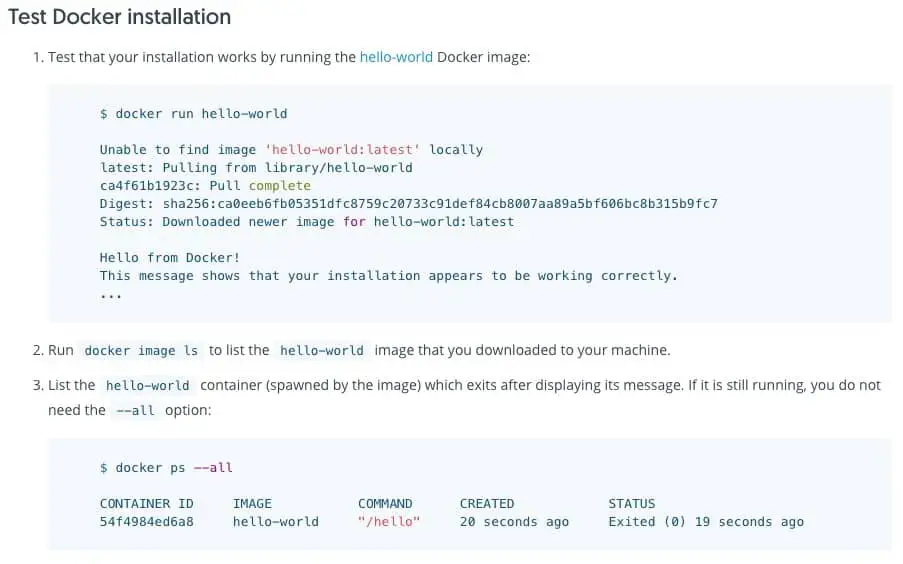
Networking
The networking domain takes 15% of the examination with technical contents which candidates are expected to be fully knowledgeable about. These technical contents include:
[wpsm_list type=”arrow”]
- Creation of a Docker bridge network that can be used by developers making use of containers.
- Troubleshooting of containers and engine logs in order to explain how connectivity issues happen between two different containers.
- Publishing of a port that can be externally accessible by third parties (people or other applications).
- Ability to identify which IP and port a container is currently being accessible externally on, and how to manage such port.
- Description of the many types and uses of cases of in-built network drivers.
- Explain how Docker can be configured to use external DNS.
- Provide an explanation as to what Container Network Model is, and how it effectively interfaces with the Docker engine, network, and IPAM drivers.
- Ability to use the Docker engine in load balancing both HTTP and HTTPS traffic to an application (Configure L7 load balancing with Docker EE).
- Ability to understand and describe the types of traffic that flow between the Docker engine, registry, and UCP controllers.
- Describe the difference between “host” and “ingress” port publishing mode.
[/wpsm_list]
[wpsm_video]https://www.youtube.com/watch?v=2vcLgcH_hDI[/wpsm_video]
Where to learn about Docker networking
Docker wouldn’t be great without networking capabilities. Docker networking is also one of the essential features that you have to master in order to pass the Docker Certified Associate (DCA) exam. To start with, you should know all of the following Docker networking commands:
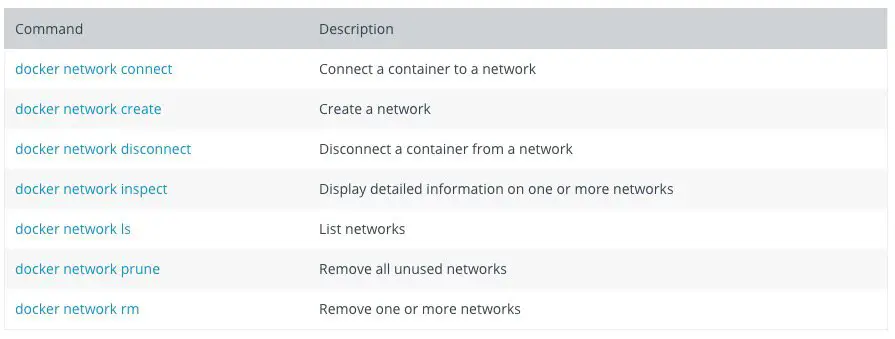
Security
The security domain also takes 15% of the examination and forms a vital part of assessing candidates who take this examination. Understanding the security of applications and activities on the Docker platform is very vital in passing this certification exam. The contents of the security domain include:
[wpsm_list type=”arrow”]
- The process of effectively signing an image, and how that image passes through a security scan.
- How Docker Content Trust can be enabled.
- The steps involved in the configuration of RBAC in UCP and integration of UCP with LDAP/AD.
- Illustrate the creation of UCP client bundles and a description of default engine security.
- Description of MTLS, engine and swarm default security
- Provision of explanation as to what identity roles are, and how they aid security.
- Ability to explain the differences that exist between UCP workers and managers on the platform.
- Understanding of the process involved in making use of external certificates alongside UCP and DTR.
[/wpsm_list]
[wpsm_video]https://www.youtube.com/watch?v=E_0vxpL_lxM&t=2s[/wpsm_video]
Where to learn about Docker security features
Because Docker has a networking feature, meaning Docker containers will be connected to a network (not necessarily), meaning you have to know the security features inside out. Try and implement the security part in your own Docker environment. If you are capable of that, try to hack your own Docker environment.
The interesting penetration test you can perform in your own environment is to try and run a web application container, make it vulnerable to some sort of attacks, exploit it, and see what happens. One mistake that developers often make is they run Docker containers in the context of the root user. Meaning, if some bad guys will hack into your application, they’ll have root privileges within your Docker process on your host machine. That’s not a good thing, isn’t it? If you want to know more about what I’ve just described, you can do so here (article called ‘Processes In Containers Should Not Run As Root’).
Also, make sure you understand everything that’s written in the official Docker documentation.
Storage and Volumes
Storage and volumes are the last domain of the Docker certification examination and it takes 10% of the exam. The contents of the storage and volume segment include:
[wpsm_list type=”arrow”]
- Ability to state the best graph driver for a particular Operating System.
- Demonstration of the steps involved in effectively configuring a device mapper.
- Ability to differentiate object storage from block storage and provide explanations as to which is best for a task.
- Understanding how volumes are used with Docker to ensure constant storage, and how storage can be used effectively across cluster modes.
- Explaining the steps to be followed in cleaning up unused images both on the file system and DTR.
[/wpsm_list]
[wpsm_video]https://www.youtube.com/watch?v=y5wMbA_T0tA[/wpsm_video]
Where to learn about Docker storage and volumes
Another important aspect to understand when preparing for Docker Certified Associate exam is storage and volumes. You need to be aware of all the options available, which one you should choose under different circumstances, and why. This is quite a big topic so take your time and study it as much as possible. You should start learning about Docker storage and volumes by reading the official documentation.
Necessary Documentation for the Exam
The official website of Docker provides for the necessary documentation needed for the examination. This documentation serves as a guide to interested candidates who intend to take the certification examination. It contains the syllabus of the exam in detail, the current criteria, and provides the necessary preparation material. This material is often revised to ensure it is fully updated with all necessary information to help candidates.
Keys to Excelling in Docker Certification Exam
Beyond knowing what to expect and how to excel in the examination, there are some helpful keys to hold on to.
Exposure and Understanding of Docker
The most important thing to note if you want to excel in the Docker certification exam is that awareness is very important. This awareness makes you exposed and experienced in the use of Docker to address real-world problems. This goes on to form a vital requirement for qualifying for the examination which is at least 6 – 12 months of Docker experience. In this period, candidates are expected to have gained the relevant knowledge on using containers effectively. A candidate with good exposure and experience of Docker stands a better chance of scoring higher in the examination.
Constant practice across various environments
From the Docker official website, you will gain access to the Docker Certified Associate online course that can be continually practiced. This practice course not only recommends suitable practice environments but allows candidates to gain an advantage to systems with multiple clusters. In choosing the best environment for practice, candidates must take into consideration the virtual systems provided. The description of the environment is also very important as it helps in analyzing the best approach to be utilized.
Understand the Sub-topics as much as the Topics
One way to effectively prepare for the Docker Certification Exam is to pay attention to the sub-topics. Candidates are to explore these sub-topics diligently especially those that relate to expertise. Whilst understanding these sub-topics, use cases must be also studied. To advance your understanding of these sub-topics, you can back them up with real-world exposure to containers and how they behave.
Test your preparation and be sure you’re good to go
After several environments have been explored and sub-topics understood, you must test your preparation level. To do this, candidates can visit the Docker website and take the Docker Certified Associate practice tests. This test has been designed to give candidates a real examination-like atmosphere. Be careful when choosing a mock exam in preparation for Docker certification as there are a lot of them out there. Make sure whichever practice test you are choosing is one that is consistent with the outline of the exam.
Training courses can significantly assist you in preparing for the Docker Certification Exam. On LinkedIn Learning, you can get a risk-free 30 days free trial, during which you can do a few Docker Learning Paths, and much more.
Checkout all Docker Learning Paths here
Conclusion
This guide aims at ensuring that every candidate looking forward to being a Docker Certified Associate achieves the aim. This guide provides you with all the necessary information to have you prepared for the certification exam. If careful attention is paid to this guide, candidates will not have to take the examination twice before becoming certified.

